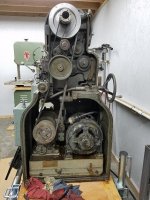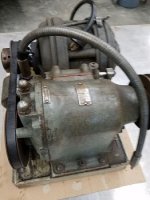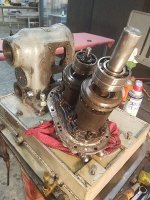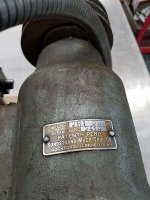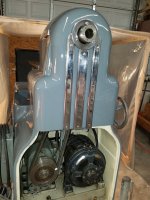Hello All!
I don't frequent this board at all, but I have been working with another Sundstrand guy, Mike Thomas, and he told me that there was some activity on this thread so I came and had a look. Good to see the activity!
I have a rather interesting (at least interesting to me!) update to tell about this thread. If one were to look all the way back to the beginning of this thread, you'd see that I had a hydrodrive that had failed and then I damaged it during the disassembly process. The update is that I was able to successfully repair the damaged casting on my Sundstrand hydrodrive and was able to rebuild the entire unit and get it back to functioning as good as new! I'm thrilled with this, as it took me about a year and a half to figure out how to fix it and to find the time to do it.
For the new guys that are looking to repair a Sundstrand, I will say this: It is actually an incredibly simple and incredibly robust piece of machinery. Since there is almost no literature available on the unit, I think that folks are timid about taking on a rebuild, and certainly so was I. However, with the help of Russ Kepler who was able to provide me with a manual on the unit, as well as the manual for my 10EE which covers some aspects of maintenance of the Sundstrand unit, along with a WHOLE BUNCH of studying the internals of the unit, I was able to learn all that I needed to know to repair the unit. Through the experience of repairing this unit, I will say that I feel I now know the inner working of the Sundstrand HydroDrive extremely well, and I feel that I can now be of assistance in the repair of any of the units that are out there needing repair. And a really important point is that needs to be made is that these units are just not that complicated, and any good mechanic/machinist can repair them, if given some guidance.
I am willing to help anyone who is interested in rebuilding/repairing their hydrodrive. I am willing to help by offering advice/consulting, or even by actually doing the repair for you as well.
I did a complete write-up of my rebuild, complete with pictures and videos. I put all of this info on DropBox, and can give anyone interested the link to the DropBox folder so they can see the pics/vids/write-up. I can even put the link here if that's acceptable to the forum, I just don't know the forum rules and I'm too lazy to go and look at them!
The biggest thing I can say is DON'T GIVE UP ON YOUR SUNDSTRAND!!! It's a great old antique, it's incredibly robust, and it powers the lathe more than well enough.
Also, regarding speed, my unit spins anywhere from a few RPM all the way up to a spindle speed of 3000 RPM, in forward. Operation is smooth throughout the speed range. Don't expect anything less from your drive, and if it's not giving you that performance, let's freshen it up and get it performing like it should!
One strange thing about my drive is that there is a speed limiter in the drive that limits the speed in reverse. It would be easy enough to remove this limiter, and I did remove it to see if it would spin the same speed in reverse that it does in forward, and it does. Ultimately though, I left the reducer in as it appears to be a part of the original casting. I have no idea why they would limit the speed in reverse, but they did. If anyone has any insight as to why they would want to limit the speed in reverse, please enlighten me.
I'm not entirely sure how to post contact info on this forum, but I'm happy to be contacted. Someone please enlighten me as to how to put my contact info out there. Otherwise, private message me and I'll send you my email address.
Keep the Sundstrand faith!
Nick


